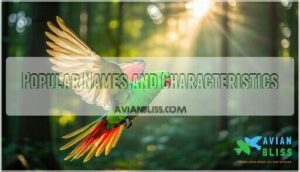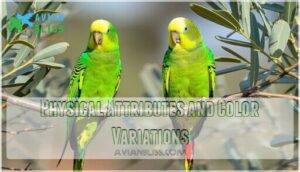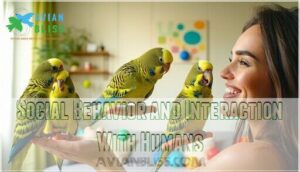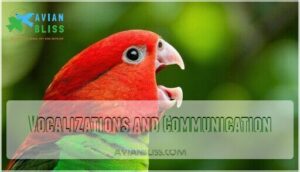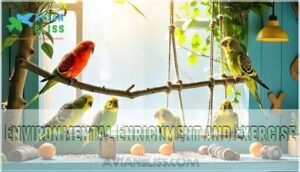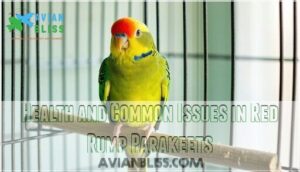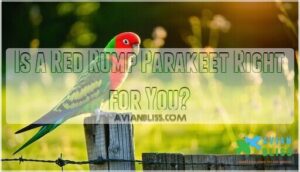This site is supported by our readers. We may earn a commission, at no cost to you, if you purchase through links.
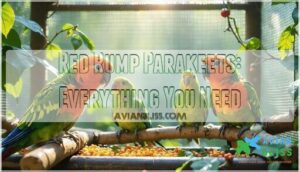
Before bringing one home, you’ll want to know they’re social birds that thrive in spacious enclosures with similar-sized birds.
They can be territorial, especially during breeding season.
You’ll need to provide a suitable diet, environmental enrichment, and regular exercise.
Understanding their behavior, housing, and care requirements is essential.
Red rump parakeets everything you need to know before getting one includes their specific needs, and by learning these, you’ll be better prepared to give your new feathered friend a happy, healthy life – and that’s just the beginning.
Table Of Contents
- Key Takeaways
- Description and Origin of Red Rump Parakeets
- Popular Names and Characteristics
- Habitat and Natural Behavior
- Appearance and Behavior of Red Rump Parakeets
- Housing and Care for Red Rump Parakeets
- Breeding and Reproduction of Red Rump Parakeets
- Health and Common Issues in Red Rump Parakeets
- Training and Taming Red Rump Parakeets
- Interacting With Red Rump Parakeets
- Is a Red Rump Parakeet Right for You?
- Frequently Asked Questions (FAQs)
- What to know about parakeets before getting one?
- What should I do when I first get a parakeet?
- Are red rump parakeets good pets?
- What is the average lifespan of a red rump parakeet?
- How noisy are red rump parakeets?
- Can they learn tricks easily?
- How often bathe red rump parakeets?
- Can red rump parakeets fly outdoors?
- Conclusion
Key Takeaways
- You’ll want to consider your lifestyle and whether it’s compatible with owning a red rump parakeet, as they require a long-term commitment and regular care.
- To keep your red rump parakeet happy and healthy, you’ll need to provide a balanced diet, a spacious cage with plenty of toys and perches, and regular social interaction and exercise.
- Red rump parakeets are social birds that thrive on attention and interaction, so you’ll need to spend time with your bird daily, teaching it tricks, and providing mental stimulation to prevent boredom.
- Before getting a red rump parakeet, you should also consider the costs and responsibilities involved, including veterinary care, food, and supplies, and make sure you’re prepared to provide the necessary care and attention for the bird’s 15-32 year lifespan.
Description and Origin of Red Rump Parakeets
You’re about to discover the Red Rump Parakeet, a species with Australian origins.
Meet the Red Rump Parakeet, a vibrant Australian bird species
Native to southeastern Australia, these birds, also known as Psephotus haematonotus, have a fascinating species history.
Their naming etymology comes from the red spot on males’ lower backs.
Early domestication of Red Rump Parakeets has made them popular pets, originating from their native habitat in Australia.
Popular Names and Characteristics
Red Rump Parakeets go by several nicknames that reflect their laid-back nature.
Bird enthusiasts often call them the "Easy Bird" or "Lazy Bird" because they’re low-maintenance pets with cheerful tweets and playful intelligence.
These medium-sized parrots showcase vibrant plumage that’s hard to miss.
Males display striking red rump colors alongside emerald green feathers, while females sport duller greens.
You’ll find their vibrant colors particularly stunning when they’re active and curious.
Key Characteristics:
- High Energy Levels – Despite their "lazy" nickname, Red Rump Parakeets are actually loving, playful, and energetic birds with good-natured personalities that make them delightful to observe during daily interactions.
These birds also have vibrant plumage colors, making them popular pets.
Habitat and Natural Behavior
Living in southeastern Australia’s open grasslands and the Murray-Darling Basin, these parakeets know the land like the back of their wing.
In the wild, their days are full of foraging habits, searching for grass seeds and tiny bugs.
The red rump habitat usually means:
- Skipping through sunlit plains
- Dodging natural predators with sharp flight patterns
- Staying close to family flocks
That social structure isn’t just for gossip—it helps them thrive.
Understanding their behavior lets you bring a bit of Australia home.
Appearance and Behavior of Red Rump Parakeets
You’ll spot red rump parakeets right away by their emerald-green feathers, bright red lower backs, and playful chirps that sound a bit like they’re telling jokes.
These clever birds aren’t just pretty faces—they’re full of personality, with curious habits and a knack for making you laugh when you least expect it, which showcases their playful nature.
Physical Attributes and Color Variations
Bird colors grab your attention, especially when you meet a red rump parakeet. Plumage colors pop on the males, whose emerald feathers, yellow bellies, and a trademark red rump set them apart.
Females? They keep it chill in olive drab, with subtler rump distinction. Feather patterns matter for size comparison and quick ID.
Red rump mutations, such as the blue or cinnamon varieties, keep life lively. These birds are commonly found in South-Eastern Australia.
Two key details:
- Sexual dimorphism is obvious.
- Color genetics create vibrant colors.
Social Behavior and Interaction With Humans
You’ll love interacting with red rump parakeets, known for their social behavior and human interaction.
As you build trust, you’ll notice their temperament shines through. With patience and training techniques, you can overcome potential aggression.
Playtime activities and socializing strategies are key to a strong bond. By understanding their social behavior, you’ll create a fun and engaging experience for both you and your red rump parakeet.
Remember, building trust takes time, so be gentle and consistent. With the right approach, you’ll enjoy a wonderful relationship with your feathered friend, filled with laughter and joy.
Vocalizations and Communication
You’ll notice their vocalizations include soft chirps, tweets, and harmonious song-like notes, used for communication and social interaction.
With mimicry ability and various bird sounds, like chirps, conveying different meanings and signals, they are able to express themselves effectively through vocalizations.
Housing and Care for Red Rump Parakeets
You’re getting ready to bring a Red Rump Parakeet home, and to provide the best housing and care for your new pet, you’ll need to set up a spacious cage with perches and toys.
To keep your bird happy and healthy, you’ll need to learn about the right diet and environmental enrichment.
Suitable Cage Size and Setup
Now that you know what red rumps look like, let’s talk about their homes. A proper bird cage setup is key! Your red rump cage needs specific bird cage dimensions.
Aim for a cage size of at least 30" x 20" x 20". Remember, pairs need double the space! To help find the right fit, consider parakeet cage dimensions for your bird.
Consider these bird cage setup tips:
- Horizontal bars for climbing.
- Perch placement variety.
- Toy selection to prevent boredom.
Don’t forget a regular cleaning routine. Proper cage size and setup keep your bird happy!
Recommended Diet and Nutrition
Once you’ve got the perfect cage setup, your red rump parakeet’s diet becomes your next priority. Think of feeding as fueling a tiny athlete – these birds need balanced nutrition to stay healthy and happy.
A proper red rump diet should include:
- Pellet Composition: High-quality parakeet pellets forming 50% of their meals
- Seed Variety: Wild seeds like millet and sunflower seeds (10% maximum)
- Fruit Selection: Fresh apples, pears, and berries as tasty treats
- Vegetable Choices: Leafy greens, carrots, and broccoli for essential vitamins
This balanced approach prevents obesity while meeting their Supplement Needs naturally through varied red rump food choices. Many owners find success with specialized parakeet feed.
Environmental Enrichment and Exercise
Red rump parakeets are intelligent, curious birds that thrive on mental stimulation and regular interaction.
These vigorous chewers benefit from bird-safe natural branches, wooden blocks, and foraging opportunities that mimic their wild behavior.
Flight space within larger cages allows proper exercise, while toy rotation prevents boredom-induced overeating.
Swings, ladders, and interactive bird toys provide climbing variety.
Social interaction through supervised outdoor access in bird-proofed rooms supports behavioral health.
Environmental enrichment keeps your feathered friend engaged and content.
Toy rotation offers powerful cognitive stimulation for your bird.
Breeding and Reproduction of Red Rump Parakeets
If you’re considering breeding your red rump parakeets, you’ll want to understand their natural reproductive cycle and specific care requirements.
These charming birds reach sexual maturity between 1-2 years old and can breed successfully throughout most of their adult lives when given proper conditions and care.
Breeding Age and Considerations
Your parakeet’s breeding journey starts around 9-10 months old, with peak fertility occurring between 1-5 years.
During breeding season (August to January), healthy pairs will naturally seek nesting boxes for their clutch size of 3-6 eggs.
Monitor your bird’s breeding age carefully—older females face increased health risks and calcium deficiencies from frequent egg-laying, affecting chick development and incubation period success.
Nesting Requirements and Behavior
Creating the perfect love nest for your red rump parakeets starts with proper nest box size—aim for deep boxes that mimic natural tree hollows.
During breeding season, you’ll witness fascinating mating habits as pairs engage in courtship displays and mutual preening.
Each breeding pair needs their own segregated aviary space for successful red rump breeding.
Once comfortable, these devoted partners will begin nesting behavior that leads to egg laying, showcasing their devoted partners nature.
Incubation Period and Caring for Chicks
When the incubation period begins, you’re in for a rollercoaster of egg candling, checking on chick development, and watching the hatching process unfold.
Keep the nesting habits cozy and don’t forget—parental birds usually handle egg laying and most chick care.
Understanding nesting material selection is key to providing a secure environment for red rump parakeets.
If you need to step in, hand-feeding chicks and smart weaning strategies will make your red rump breeding a breeze!
Health and Common Issues in Red Rump Parakeets
You want your red rump parakeet to stay healthy, so it’s important to watch for signs of illness, like messy feathers or a quiet mood.
With regular check-ups and a bit of attention, you’ll catch problems early—no parakeet likes surprise beak trims!
Catch health issues early to keep your parakeet happy and thriving
Signs of a Healthy Bird
With keen eyes, you’ll spot a healthy red rump parakeet through several telltale signs.
Watch for vibrant plumage condition—smooth, glossy feathers without bare patches.
Their alertness level should be high, showing curiosity and responsiveness.
Healthy eating habits include steady appetite and active foraging.
Check dropping consistency; they should be firm with clear liquid portions.
Common Health Problems and Prevention
Understanding red rump health means recognizing warning signs before problems escalate. Obesity from excessive seed consumption tops the list of red rump diseases, leading to respiratory issues and shortened lifespans.
Feather plucking often signals stress or poor nutrition. Watch for psittacosis symptoms like discharge and lethargy.
Proventricular dilatation causes weight loss despite good appetite. Beak disorders and aspergillosis prevention require proper hygiene and diet monitoring for ideal bird health.
Veterinary Care and Regular Check-ups
Regular veterinary care keeps your Red Rump Parakeet healthy and happy.
An avian veterinarian should examine your bird annually to catch problems early. Don’t wait until emergency signs appear—preventative care saves lives and money.
- Annual exams help detect red rump diseases before they become serious health issues
- Parasite control prevents common problems that affect bird health and energy levels
- Emergency signs like discharge or behavior changes need immediate veterinary care attention
Training and Taming Red Rump Parakeets
You’re about to learn how to train and tame your Red Rump Parakeet, which is an exciting step in building a strong bond with your pet.
By following some simple steps and techniques, you can teach your parakeet to trust and interact with you, making your relationship a fun and rewarding experience.
Bonding and Building Trust
Building trust with your red rump parakeet is like slowly earning the trust of a shy friend—patience is key! Use positive reinforcement and watch your bird’s body language.
Spend a little time every day just hanging out near the cage, letting them get used to your voice. Try hand feeding and allow gentle handling in a safe environment.
Consistent interaction makes a huge difference. Before you know it, your parakeet will look forward to these moments and begin to enjoy your company.
- Spend quality time together
- Offer treats as rewards
- Hand feed for positive associations
- Handle gently and patiently
- Allow supervised exploration
Basic Training Commands and Tricks
Once your red rump parakeet trusts you, it’s time for real bird training fun.
Start with the Step-Up Command—like a parakeet’s handshake—then move to Target Training using a stick or finger.
Add Recall Training and a Trick Variety, such as waving or spinning.
Use Positive Reinforcement with treats or a happy “good bird!” to keep lessons upbeat.
Remember, patience wins; bird intelligence can surprise you!
For effective training, utilize positive reinforcement techniques.
Handling and Socializing Techniques
Hand-feeding success stories begin with patience and consistency. Your red rump parakeet needs gentle, predictable approaches to build trust through positive reinforcement.
Start with calm presence near their cage, then gradually introduce treats from your palm.
Essential socialization steps:
- Daily exposure – Spend quiet time near the cage without forcing interaction
- Slow movements – Sudden gestures trigger panic and setback your progress
- Respect boundaries – Watch for stress signals like rapid breathing or feather fluffing
Early interactions shape your bird’s comfort with handling frequency. Create a peaceful socialization environment where your parakeet feels secure.
Remember, these intelligent birds read your energy – stay relaxed and let them set the pace for meaningful connection.
Interacting With Red Rump Parakeets
You’re about to learn how to interact with your Red Rump Parakeet, which is an exciting part of owning one.
By spending time with your bird, you’ll create a strong bond and understand its needs, making your experience as a pet owner even more enjoyable, with a deeper understanding of its needs.
Playtime and Mental Stimulation
You’ll keep your Red Rump Parakeet happy with interactive toys, foraging games, and puzzle toys, preventing boredom and stimulating intelligence.
Making playtime fun and engaging, with enrichment ideas and training techniques to promote bird stimulation.
Toys and Activities to Keep Them Engaged
You’ll want to engage your red rump parakeet with foraging toys, puzzle feeders, and flight opportunities to prevent boredom and stimulate their mind, ensuring a happy and active bird with plenty of social interaction and mimicry training using various bird toys.
Owners often seek durable parakeet playthings for their birds, which can help with mimicry training and provide social interaction.
Enjoying Their Company and Creating a Bond
To truly connect with your red rump parakeet and foster a strong bond, you should lean into their social behavior.
- Building Trust through gentle handling is key.
- Engage in Interactive Play to stimulate their curious minds.
- Vocal Bonding happens when you teach tricks.
- Shared Activities and Positive Reinforcement will make red rump training easier, improving their red rump temperament through positive reinforcement.
Is a Red Rump Parakeet Right for You?
You’re considering getting a Red Rump Parakeet, but you want to make sure it’s the right fit for you.
Before bringing one home, this is vital to understand the responsibilities of ownership and the time commitment required to care for these beautiful, playful birds.
Considerations Before Getting a Red Rump Parakeet
Now that you’re ready to interact with these charming birds, let’s pause.
Before you welcome a red rump parakeet, consider if it fits your lifestyle.
- Lifestyle Compatibility: Does your schedule allow for red rump care?
- Noise Levels: Are you prepared for cheerful tweets?
- Family Allergies: Verify everyone is safe.
- Commitment Length: Remember the red rump lifespan.
- Legal Restrictions: Check local laws.
Understanding the red rump temperament and red rump price helps too!
Time Commitment and Daily Care
You’ll need to balance daily routines, like feeding and cleaning, with enrichment activities.
Consider:
- Daily care tasks
- Cleaning schedules
- Vacation planning for your red rump’s care, ensuring a long-term commitment to their well-being.
Understanding The Responsibilities of Ownership
You’re considering a red rump parakeet as a pet bird.
| Bird Care | Costs | Time |
|---|---|---|
| Dietary needs | $50/month | 1 hour |
| Enrichment | $20/month | 30 min |
| Veterinary | $30/visit | 1 hour |
| Social interaction | free | 2 hours |
Lifespan commitment is key.
Frequently Asked Questions (FAQs)
What to know about parakeets before getting one?
Before getting a parakeet, know they’re social, require space, and live 15-32 years, needing a long-term commitment and proper care.
What should I do when I first get a parakeet?
You’ll want to set up a comfortable cage, provide fresh food and water, and let your parakeet adjust to its new environment slowly, with gentle interaction and patience.
Are red rump parakeets good pets?
Verily, you’ll find red rump parakeets make fantastic pets, offering playful, affectionate companionship with proper care and attention, they’re relatively low-maintenance and fun.
What is the average lifespan of a red rump parakeet?
You can expect your red rump parakeet to live between 15 to 32 years, requiring a long-term commitment to care for these beautiful, playful birds.
How noisy are red rump parakeets?
Like a songbird, you’ll find red rump parakeets are relatively quiet, producing cheerful tweets that resemble songs, making them a pleasant companion with a gentle, melodious voice.
Can they learn tricks easily?
You can teach them tricks easily, as they’re playful and intelligent, capable of mimicking human speech with patience and practice, making them fun and engaging pets.
How often bathe red rump parakeets?
You’ll bathe your red rump parakeet occasionally, as they’re relatively low-maintenance, but a shallow dish of water for splashing and preening should be provided regularly for hygiene and enjoyment.
Can red rump parakeets fly outdoors?
You can let your red rump parakeet fly outdoors, but guarantee its safety with a secure, escape-proof aviary or a supervised flight in a fenced area.
Conclusion
Now you’re ready to bring home a red rump parakeet, consider "red rump parakeets everything you need to know before getting one" to guarantee a happy life for your bird.
Providing the right care, social interaction, and attention to their specific needs, making you a great owner.
- https://www.birdcagesnow.com/blogs/bird-blog/red-rump-parakeet-species-guide
- https://en.wikipedia.org/wiki/Omnivore
- https://www.parrots.org/encyclopedia/red-rumped-parrot/
- https://www.xeno-canto.org/sounds/uploaded/EHGWCIGILC/XC286929-red-rumped-parrot-nyngan1.mp3
- https://www.msdvetmanual.com/exotic-and-laboratory-animals/pet-birds/toxicoses-of-pet-birds

